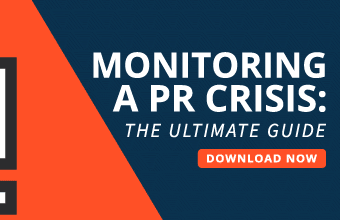Have you ever had that awful feeling when your company’s good name was at risk? Like when a tweet backfires big time or news outlets can’t stop talking about you pulling a product off the shelves?
Well, PR crises used to be slower burns. But not anymore! Because of social media, things are moving at a 10x speed, and companies are struggling to keep up. Trying to watch all those platforms, hit back with lightning-quick replies, and create the perfect message when things go south—it’s all exhausting and often feels impossible at times.
That’s where AI steps in. From monitoring conversations in real-time to creating rapid responses, AI is changing crisis management in PR.
But again, the question arises: How much do we rely on AI for these sensitive situations? Where to draw the line between efficiency and authenticity?
In this blog post, you’ll learn what PR crisis management is, how to prevent PR crises, and, most importantly, how to leverage AI for crisis management in public relations. So, let’s get started.
Understanding PR crisis management
Remember when United Airlines forcibly dragged a passenger off an overbooked flight? Or when Pepsi’s tone-deaf ad with Kendall Jenner sparked outrage?
Yup, those are examples of PR crises—situations that push companies into the spotlight for all the wrong reasons. Such cases are every company’s worst nightmare.
PR crisis management is all about keeping a brand’s reputation safe when things go sideways. It’s the strategic process of planning ahead, getting on problems quickly, and bouncing back after stuff happens that could make an organization look bad or shake up how folks think about it.
You could say it’s like being a reputation saver during emergencies. Say a product’s gotta be taken off the shelves, people are freaking out on Twitter, or some big boss gets caught in a mess—PR crisis management is essential.
The goal here is to minimize damage, maintain trust, and take the narrative in a more positive direction.
Key elements of PR crisis management
At its core, PR crisis management involves:
- Preparation: You need a game plan for when rough times hit. Figure out what can go wrong and how to talk your way through it. Identify potential risks and craft response strategies.
- Quick Response: When a crisis hits, time is of the essence. PR teams need to act fast to control the narrative.
- Clear Communication: Keeping all stakeholders—from customers to employees to shareholders—in the loop with transparent, consistent messaging.
- Damage Control: Taking steps to mitigate the negative impact on the brand’s reputation.
- Learning and Adapting: Look at the crisis as a chance to learn and stop the same mess from happening again.
The goal? To guide your organization through the storm with minimal damage to your reputation and, ideally, to come out stronger on the other side. Nowadays, a rock-solid PR crisis playbook is super important—it’s not just a bonus, it’s straight-up necessary.
So, the next time you spot a business navigating a potentially disastrous situation gracefully, know that there’s an amazing PR crisis management strategy behind the scenes. And with AI, things are now even smarter and more efficient than ever before.
Leveraging AI for Crisis Management in Public Relations
Call it a game changer, but using AI is transforming the way we deal with crisis management in PR. It offers tools that make us way better at spotting trouble, reacting quickly, and stopping things from getting worse. Here’s how brands can leverage AI for crisis management in PR:
1) Early Warning Systems
AI-powered sentiment analysis tools can monitor millions of online conversations, social media, news outlets, and online forums in real-time, detecting potential issues before they escalate into full-blown crises. It picks up on stuff that might blow up into a big deal before it does.
Action step: Get AI tools for social listening working. You want them to alert you when there’s a sudden jump in bad vibes or certain words popping up, which might point to big trouble. This could give you some time to figure out what to do next.
2) Predictive Analytics
Machine learning algorithms can analyze historical data to predict potential crisis scenarios and their likely outcomes. Having this heads-up lets PR teams get their act together before things go south.
Action step: Use platforms for predictive analytics. Look for trends in past messes to guess what headaches might come knocking down the line.
3) Automated Response Generation
NLP, or Natural Language Processing, can help draft initial responses to common crisis scenarios, ensuring quick, consistent communication across channels. It keeps the talk fast and the message the same no matter where you’re putting it out there.
Action step: Get an AI chatbot going on stuff like ChatGPT or other alternatives to ChatGPT. This intelligent assistant can take on the easy questions when things go sideways. Let your team stick to the big-deal decisions.
4) Personalized Stakeholder Communication
AI can segment audiences and tailor messages based on who they are, what they did before, and how they’re feeling at the moment. This means you get way better at talking to people when there’s trouble , fostering customer loyalty during challenging times
Action step: Put AI to work, checking out what your key people like and what they’ve done before. This helps you come up with stuff to say that hits home when everything’s a mess.
5) Real-time Media Monitoring
AI can track and analyze media coverage across various platforms, providing instant insights into how the crisis is being portrayed and which narratives are gaining traction.
Action step: Employ media monitoring tools with AI capabilities for real-time updates and analysis of crisis coverage.
6) Crisis Simulation and Training
AI can generate super convincing emergency situations for training purposes, giving PR people the chance to sharpen their comeback tactics in a no-risk zone.
Action step: Conduct regular AI-driven crisis simulations with your team to keep skills sharp and plans up-to-date.
7) Post-Crisis Analysis
AI can process vast amounts of data to provide an in-depth analysis of how the crisis unfolded, the effectiveness of the response, and lessons for future preparedness.
Example: After a crisis, use AI to analyze media coverage, social media reactions, and customer feedback to gauge the impact on your brand reputation and identify lessons for future crisis management.
8) Deepfake Detection
With tech stepping up its game, AI becomes a key player in spotting and tackling deepfakes or altered videos that might kick off or worsen a crisis.
Action step: Invest in AI tools that can quickly verify the authenticity of images and videos related to your brand. This makes it easier to call out the fake stuff when things get rough.
9) Automated Reporting
With AI, reports on emergencies come out super fast, which lets the PR folks concentrate on strategy and stakeholder engagement.
Action step: Start using smart AI report-making things to create instant, data-driven crisis updates for your team and leadership.
10) Ethical Considerations
While leveraging AI, it’s crucial to maintain transparency and human oversight. AI is there to give a helping hand, not kick human thinking to the curb when the situation is all delicate.
Action step: Create straightforward rules to guide AI in managing crises, ensuring humans review all AI-crafted messages before they go out.
Keep in mind AI is a major player when dealing with tough spots, but it’s not there to swap out human smarts and hearts.
The most effective crisis management strategies combine AI’s analytical power with human creativity, emotional intelligence, and ethical decision-making.
Practical Tips for Getting Started with AI in PR Crisis Management
1) Start Small
- Start with basic AI-powered monitoring tools: Start by implementing AI tools that can monitor social media, news outlets, and online forums for brand mentions and potential crisis triggers.
- Gradually expand capabilities: As your team becomes more comfortable with AI, introduce more advanced features like sentiment analysis or predictive modeling.
- Keep learning: Use each implementation as a learning opportunity. What worked? What didn’t? Use these insights to refine your approach.
- Track and measure your AI progress by establishing clear KPIs to evaluate the effectiveness of each new feature and its impact on team performance.
- Pro Tip: Choose one specific area of crisis management to focus on initially, such as early warning detection. Master this before moving on to more complex applications.
2) Build Team Capability
- Invest in training your team about AI: Ensure your team understands the basics of AI, its capabilities, and its limitations. Consider bringing in experts for workshops or enrolling team members in online courses.
- Develop clear protocols: Create step-by-step guidelines for using AI tools in crisis situations. This should include when to rely on AI insights and when human judgment is crucial.
- Encourage experimentation: Set aside time for your team to explore new AI tools and techniques in a low-stakes environment. This could be through regular “tech exploration” sessions or hackathons.
- Pro Tip: Designate an “AI champion” within your team who can lead the charge in exploring new technologies and sharing knowledge with others.
3) Measure and Adapt
- Track key metrics: Establish clear KPIs for your AI implementations. This could include metrics like response time reduction, accuracy of crisis predictions, or sentiment improvement rates.
- Gather team feedback: Regularly check in with your team about their experiences using AI tools. What’s working well? Where are they struggling?
- Adjust strategies as needed: Be prepared to pivot your approach based on the data and feedback you gather. AI in PR is a rapidly evolving field, so flexibility is key.
- Pro Tip: Create a dashboard that visualizes your AI-related KPIs alongside traditional PR metrics. This can help demonstrate the value of AI to stakeholders and inform strategic decisions.
Remember, implementing AI in PR crisis management is a journey, not a destination. Start small, learn continuously, and don’t be afraid to adjust your approach as you go.
Start leveraging AI for crisis management in PR
The future of PR crisis management is here, and it’s powered by AI. But don’t forget nailing the mix between tech and human touch is key.
With AI, you get a bunch of cool stuff for spotting, examining, and tackling crises. Yet, you can’t ignore human traits like empathy, judgment, and creativity.
Start small, think big, and always keep learning.
Remember: In crisis management, it’s not about having the most sophisticated tools—it’s about using them wisely to protect and enhance your brand’s reputation.








